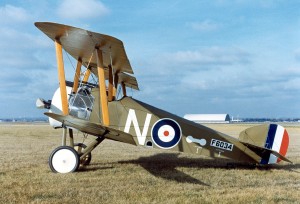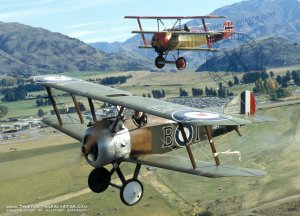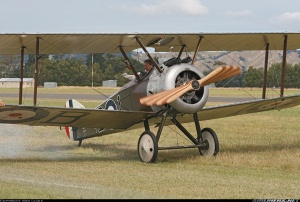This week’s plane of the week is the Sopwith Camel.
The Sopwith Camel was a British World War I single-seat biplane fighter introduced on the Western Front in 1917. Manufactured by the Sopwith Aviation Company, it had a heavy, powerful rotary engine, and concentrated fire from twin synchronized machine guns. It was difficult to handle but very maneuverable and an excellent fighter. The Sopwith Camel was credited with shooting down 1,294 enemy aircraft, more than any other Allied fighter of the war. It also served as a ground-attack aircraft, especially towards the end of the war, by which point it was outclassed in the air-to-air role.
The Sopwith Camel was designed based off the earlier Sopwith Pup. The Pup had suffered a similar fate to that which the Camel suffered towards the end of the war in that it was outdated and outclassed. The Camel was larger, faster, more maneuverable and had a large hump in it where the breeches of the twin Vickers machine guns were covered to protect it from the cold. This led pilots to call it the Camel, which was never an official name. It was officially the Sopwith Biplane F.1. However, I chose to use “Camel” for this article due to it being the more common name. After all, Snoopy didn’t fly a Sopwith Biplane F.1, he flew a Sopwith Camel, despite them being one and the same.
The Sopwith Camel was very difficult to fly. It is suspected to be because of a combination of the gyroscopic effects of its powerful rotary engine and its forward center of gravity. It was known as a killer of lesser pilots. I personally suspect that the reason it became the most well-known fighter of World War I is because among the pilots, the Camel was probably considered the “best” plane to fly because it was so challenging. If you could master it, you were the coolest pilot in your neighborhood. It was also credited with being the plane that shot down the Red Baron. Thus, the Camel went down in legend among British pilots and this bled through to their children, who kept this love of the plane going even today. There have been two LEGO sets to date that are highly detailed replicas of the Camel, more than any other one anything. However, there are only eight surviving Camels and thirteen reproductions in existence. So all recent pictures you see on the Internet of the Camel are of one of 21 planes. There are probably thousands of LEGO Camels for each real one, including the reproductions. That’s kind of unfortunate.
The Camel appears in literature and popular media as the following:
One of the aircraft flown by Canadian pilot Arthur Roy Brown in the 2008 movie The Red Baron.
The scout flown by the Royal Flying Corps Squadron in the semi-autobiographical air combat book Winged Victory written by Victor Maslin Yeates.
The fighter flown by Biggles in the novels by W.E. Johns during Biggles’s spell in 266 Squadron during the First World War. The first collection of Biggles stories, titled The Camels are Coming, was published in 1932.
The type of aircraft flown by John and Bayard Sartoris in William Faulkner’s Flags in the Dust.
In the Percy Jackson book The Titan’s Curse, Annabeth’s father, a historian, uses a restored and modified Sopwith Camel to aid the heroes at one point during the novel.
Robert Redford’s character flies a Sopwith Camel during the climactic aerial battle scene in the 1975 film The Great Waldo Pepper. And last but certainly not least, it was the plane flown by Snoopy in Charles Schultz’s Peanuts comics.
Of course, I use the term “popular” lightly, because I’ve only heard of two of those.
Contact!
Coming soon: a review of LEGO 10226 Sopwith Camel.
Next week: the Flying Boxcar. Yes, that was its real name.











Nice! It would be cool to see one in person! Are there any in museums?
LikeLike
I think there might be one in Ohio.
LikeLike